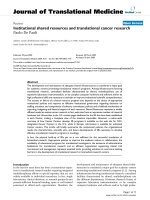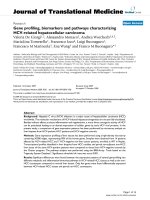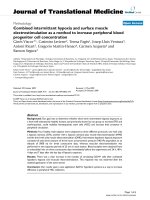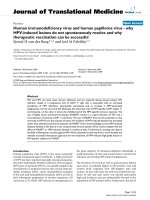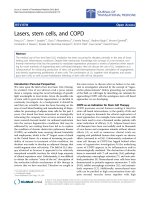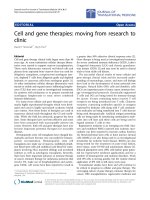Báo cáo hóa học: " Photoinduced oxygen release and persistent photoconductivity in ZnO nanowires" pdf
Bạn đang xem bản rút gọn của tài liệu. Xem và tải ngay bản đầy đủ của tài liệu tại đây (596.11 KB, 7 trang )
NANO EXPRESS Open Access
Photoinduced oxygen release and persistent
photoconductivity in ZnO nanowires
Jiming Bao
1
, Ilan Shalish
2
, Zhihua Su
1
, Ron Gurwitz
2
, Federico Capasso
3*
, Xiaowei Wang
4
and Zhifeng Ren
4
Abstract
Photoconductivity is studied in individual ZnO nanowires. Under ultraviolet (UV) illumination, the induced
photocurrents are observed to persist both in air and in vacuum. Their dependence on UV intensity in air is
explained by means of photoinduced surface depletion depth decrease caused by oxygen desorption induced by
photogenerated holes. The observed photoresponse is much greater in vacuum and proceeds beyond the air
photoresponse at a much slower rate of increase. After reaching a maximum, it typically persists indefinitely, as
long as good vacuum is maintained. Once vacuum is broken and air is let in, the photocurrent quickly decays
down to the typical air-photoresponse values. The extra photoconductivity in vacuum is explained by desorption
of adsorbed surface oxygen which is readily pumped out, followed by a further slower desorption of lattice
oxygen, resulting in a Zn-rich surface of increased conductivity. The adsorption-desorption balance is fully
recovered after the ZnO surface is exposed to air, which suggests that under UV illumination, the ZnO surface is
actively “breathing” oxygen, a process that is further enhanced in nanowires by their high surface to volume ratio.
Background
Semiconductor nano wires provide a natural, ready-made
structure in applications where small dimensions are
required [1-3]. Their small diameter (≤100 nm) implies
that a host of surface effects can influence their electri-
cal and optical properties, which is important for the
functionality and performance of nanow ire-based
devices [4-6]. Some observations such as enhanced gas
sensitivity and photoconductivity, nowadays reconfirmed
in ZnO nanowires [7-11], have been known in ZnO
whiskers and thin films , and several attempts have been
made to explain their occurrence [12-14]. The element,
proposed here to tie together the various pieces of the
puzzle into a single comprehensive model, is a fully
reversible carbon-catalyzed photolysis, where carbon is
omnipresent due to the pervasiveness of surface hydro-
carbons, capable of exposing zinc on ZnO surfaces upon
ultraviolet (UV) exposure. This surface effect is more
pronounced and easily observed in structures of high
surface-to-volume ratio, such as nanowires.
ZnO is a wide bandgap semiconductor material that
has been attracting considerable research interest for
many years. It has recently seen a renaissance due to
reports of successful p-type doping [15], room-tempera-
ture ferromagnetism which could make it attractive for
spintronic devices [16], and the large exciton binding
energy which makes it attractive for photonics [17].
ZnO nanowire applications such as lasers, light-emitting
diodes, nanogenerators, and field emitters have been
reported [18-21]. In most of these applications, the typi-
cal surface sensitivity of the nanowire structure is often
a disadvantage. However, ZnO nanowires are also f ind-
ing use as gas sensors and UV detectors [7-11,22].
These nanowire senso rs make use of the known surface
sensitivity of ZnO which is further enhanced by the
nanowire structure. The nature of th is sensitivity has
been controversial for over half a century [12-14,23,24].
Nanowires provide a new opportunity to look at the
underlying mechanism of this surface sensitivity, whic h
is the purpose of this work.
It has been known for many years that when ZnO
films are exposed to above-bandgap (UV) illumination,
their conductivity increases rapidly but persists long
after the UV light is turned off [13]. This persistence
has been shown to depend on the availability of ambient
oxygen and has led to the suggestion of surface electron
depletion region tightly related to the surface density of
negatively charged adsorbed oxygen species (
O
−
2
,O
−
−
2
)
* Correspondence:
3
School of Engineering and Applied Sciences, Harvard University, Cambridge,
MA 02138, USA
Full list of author information is available at the end of the article
Bao et al . Nanoscale Research Letters 2011, 6:404
/>© 2011 Bao et al; licensee Springer. This is an Open Access arti cle distributed under the terms of the Creative Commons Attribution
License ( ), which permits unrestricted use, distribution, and reproduction in any medium,
provided the original work is properly cited.
[13]. UV light causes this loosely bound oxygen to des-
orb from t he surface at an inc reased rate, shifting the
balance from adsorption to desorption. This reduces the
surface electron depletion region leading to enhanced
photoconductivity.
In vacuum, desorbed oxygen is pumped away. There-
fore, this state of oxygen depletion may persist for as
long as good vacuum is maintained. The density of
these loose species of surface oxygen may be totally
eliminated in va cuum, and therefore, one may expect
under the same UV photon flux a somewhat higher con-
ductivity to be reached in vacuum compared with that
in air. The common observation is, however, of a much
larger increase [7-11]. As we here report, the rate of
photocurrent increase in ZnO nanowires associated with
oxygen desorption in vacuum shows in fact two pro-
cesses: one fast at a rate comparable to that in air and
another one much slower that continues long after the
first process has ended.
In the pioneering study on ZnO whiskers by Collins
and Thomas [12], it was argued that the disappearance
of the depletion r egion in vacuum alone cannot account
for the large increase in conductivity and that a Zn-rich
conduct ive layer, created by surface photolysis of lattice
oxygen, was responsible for the large increase in photo-
conductivity observed in vacuum [12]. The large sur-
face-to-volume ratio in the nanowire structure should
enhance this effect, and indeed, several recent studies
on ZnO nanowires have pointed out such increased
photocurrent in vacuum [7-11].
In this work, we investigated photoconductivity of
ZnO single nanowires in air and va cuum, and we found
that the photoconductivity is much larger in vacuum
tha n in air. We argued that this much enhanced photo-
conductivity arises from the decomposition of ZnO -
surface photolysis of ZnO, and it cannot be explained
by simple desorption of absorbed oxygen species. We
further proposed that the ZnO photolysis is photocata-
lyzed by surface carbon, giving rise to the release of oxy-
gen species in the form of carbon dioxide.
Methods
ZnO nanowires in this study were synthesized by chemi-
cal vapor deposition using the vapor-liquid-solid techni-
que [25]. Carbothermally reduced ZnO was used as the
source material, and the gold nanoparticles were used as
catalyst to seed and control the growth on a silicon sub-
strate. Crystalline quality was assessed using transmis-
sion electron microscopy (TEM). ZnO nanowire
phot oconductors were prepared on an oxidized Si wafer
with a 1-μm-thick silicon dioxide insulating layer. Elec-
trical contacts were defined by electron-beam lithogra-
phy and lift-off. They consisted of 5-nm thick of
titani um and 50-nm thick of gold deposited sequentially
using thermal evaporation. To achieve ohmic character-
istics, the devices were then thermally treated for 10
min at 400°C in a mixed gas of 5% hydrogen and 95%
helium at a total flow rate of 200 sccm.
Photo luminescence was excited using the 325-nm line
of a He-Cd laser. Photoconductivity measurements were
carried out at room temperature in a quartz-window
optical cryostat, which can be filled with air or pumped
to a vacuum of less than 10
-5
Torr. A high-pressure
mercury lamp was used as a UV light source, and a
bandpass filter (313-nm center wavelength, 10-nm band-
width) was used to obtain monochromatic UV light
from the mercury lamp.
Results and discussion
A scanning electron microscopy (SEM) image of a typi-
cal ZnO nanowire device is shown in the inset of Figure
1. Seventeen of such devices were fabricated, and they
showed similar performances. All data shown in this
paper are from the same r epresentative device. Under
weak illumination (UV intens ity <1 W/cm
2
), photolumi-
nescence was found to be do minated by green emission,
centered at approximately 2.15 eV. This luminescence is
a ubiquitous feature of fine structured ZnO and has
been recently suggested to originate at the ZnO surface
[5]. Figure 1 shows the current-voltage (I-V) characteris-
tics in the dark. The linear I-V relations indicate the
desired Ohmic behavior of the contacts. The observed
dark currents were low both in ai r and in vacuu m, with
a slightly greater value in vacuum.
Figure 2 shows the time response of the photocurrent
in air. Upon exposure to UV light, the photo current
rises rapidly, reaching a steady-state value in several
minutes. However, when the UV light is turned off, the
current decays slowly following a short rapid decay. The
overall decay is not exponenti al and slows down further
over time. The current takes more than 10 h to return
to the original dark value. The inset in Figure 2 shows
the steady-state photocurrent as a function of light
intensity. The current is clearly not a linear function of
the intensity.
A ver y different photoresponse is observed in vacuum.
Figure 3 shows the photocurrent at three different UV
intensities. Upon exposure to UV illumination, a short
rapid photocurrent increa se is observed for all t he three
intensities, followed by a slow increase. Steady state is
not reached even after 5 h, although the photocurrents
are already 20 times as large as those observed in air for
the same intensity. When the light is turned off, the cur-
rent shows only a small decay.
To obtain the maximum steady-state photocurrent in
vacuum, we used the entire spectrum of the mercury
lamp by removing the 313-nm bandpass filter. The total
UV intensity above the ZnO bandgap was about 3 0
Bao et al . Nanoscale Research Letters 2011, 6:404
/>Page 2 of 7
mW/cm
2
. The corresponding time response of the
photocurrent is shown in Figure 4. A steady-state cur-
rent of about 8.5 μA is reached after approximately 8 h
of illumination. This current is not much larger than
the currents in Figure 3, although the incident light
intensity has been increased by an order of magnitude.
As in Figure 3, the current follows a very slow decay
pattern in vacuum, after the light is turned off, falling
about 5% in the first day.
Persistent photoconductivity in ZnO has been
observed in most of its known structures: thin films,
microneedles, and nanowires (except, of course, for
quantum dots because at least one dimension is
required for conduction) [10,12,14,22]. Besides, by
release of trapped electrons, carriers are also created
through photogeneration of electron-hole pairs. To
obtain an upper limit for this contribution, we note that
the ZnO absorption length for l ight at 313 nm is com-
parable to the wire diameter (approximately 100 nm)
and assume that all of the incident light is absorbed.
Figure 1 Dark current versus voltage of the ZnO nanowire.In
air (unfilled squares) and in vacuum (filled squares). The
measurement was performed after the device was kept in the dark
for several days. Inset: SEM image of the device. The diameter of
the wire is approximately 110 nm, and the gap between the
electrodes in test is approximately1.8 μm.
Figure 2 Transient photocurrent of the ZnO nanowire in air
under UV illumination. The intensity of the l = 313 nm light is
approximately 1.3 mW/cm
2
. Inset: steady-state photocurrent versus
light intensity in air. The bias voltage is 0.3 V and is the same for all
other photocurrent measurements.
Figure 3 Photoconductivity at three UV intensi ties in vacuum.
Same bias voltage and UV wavelength as in Figure 2. The steady-
state currents have not been reached after about 5 h. The wire is
kept in vacuum until air is let in after about 12 h (marked by a
vertical arrow). The current at t = 0 is higher than that in Figures 1
and 2 because the UV was turned on before the dark current had
reached its minimum.
Figure 4 Photoconductivity of the ZnO nanowire in vacuum
when illuminated with multi-line UV light. Light intensity is
approximately 30 mW/cm
2
. The bias voltage is 0.3 V.
Bao et al . Nanoscale Research Letters 2011, 6:404
/>Page 3 of 7
Since ZnO is a direct bandgap semiconductor, the life-
time of photogenerated electron-hole pairs is shorter
than 1 ns [26,27]. Taking for the lifetime 1 ns and
assuming for the UV intensity the experimental value of
≈3.0 mW/cm
2
,thegeneratedelectrondensityis
approximately 5 × 10
11
/cm
3
, and the corresponding
photocurrent at 0.3 V bias voltage across the approxi-
mately 1.8 μm distance between two electrodes (see Fig-
ure 1) is about 2.5 × 10
-4
nA, assuming an electron
mobility of app roximately 20 cm
2
/Vs [9,10]. This cur-
rent is about six orders of magnit ude less than the dark
current we observed. Optically excited carriers may
decay into excitons which have a longer lifetime, but
excitons do not contribute to the photoconductivity due
to the charge neutrality. We therefore may safely neglect
the contribution of photogenerated free carriers to the
photocurrent in our case of weak illumination.
Undoped ZnO typically shows n-type conductivity,
often suggested to be related to oxygen vacancies
[7,9,10,12,28]. However, first-principles calculations
showed that oxygen vacancies are not a shallow donor
but rather a deep level [29]. Oxygen vacancies are more
likely to be found close to surfaces, especially in the
case of nanowires, and thereby to serve as surface traps
[9,10,28,30,31].
Electron trapping associated with oxygen adsorption
may be described by:
O
2
(g) + e
−
→ O
−
2
(ad
)
(1)
where O
2
(g) and
O
−
2
(ad
)
indicate oxygen in its free
and adsorbed states, respec tively. The reverse process,
desorption of oxygen from the surface, requires a photo-
generated hole:
h
+
+O
−
2
(ad) → O
2
(g
)
(2)
Trapping of electrons charges the surface negatively,
creating a non-conducting depletion layer under the
surface. As previously discussed, a decrease or disa p-
pearance of this depletion layer under UV illumination
underlies the photoconductivity of Zn nanowires. In the
dark, reducing the oxygen pressure has only a minor
effect on the adsorbed oxygen. This is evident in the
rather minor change of conduction in vacuum from that
in air prior to UV exposure, as shown in Figure 1.
Figure 5 schematically illustrates the depletion layer
profile in a ZnO nanowire in the dark and under illumi-
nation. As we observe, a rather low dark conductivity,
compared wit h the photoconductivity under UV illumi-
nation, we assume that the wire is almost entirely
depleted in the dark (Figure 5A). Later on, we shall jus-
tify this assumption quantitatively. The observed green
subbandgap luminescence, centered at approximately
2.15 eV, has been previously suggested to be the result
of surface Fermi level pinning at approximately 1.15 eV
below the conduction band which implies a band bend-
ing potential, F ≈ 1.15 V [30,31]. Onc e UV light is
turned on, o xygen molecules are desorbed, as photoex-
cited holes become available, thereby reducing the sur-
face potential F and the corresponding depletion width
until a steady state is reached. Photoconductivity reflects
the formation of a non-depleted core at the center of
thewire,wheretheelectrondensityisgivenbythe
doping level n. The changes of surface potential and
the corresponding depletion width are determined by
the interplay between oxygen adsorption and the net
desorption rate which is a function of UV light inten-
sity [32]. However, because of the relatively high oxy-
gen partial pressure in air, total elimination of the
depletion region a nd of the corresponding band bend-
ing would require extremely high illumination inten-
sity. The maximum achievable photoconductivity
should correspond to the native electron density
n [33]. This explains why the saturation value of the
photocurrent increases sublinearly with illumination
intensity (Figure 2) [32,33].
As the illumination is turned off, adsorbed oxygen
molecules trap electrons, gradually bending the bands,
raising the surface potential barrier and the internal
field. This reduces electron trapping at the surfa ce,
the reby reducing oxygen adsorption, and promotes spa-
tial separation of electrons and photogenerated holes,
thereby increasing their recombination lifetime. This
positive f eedback cycle qualitatively explains the persis-
tence and non-exponential decay of the photocurrent as
shown in Figures 2, 3, and 4.
In air, the discharging of the oxygen-related surface
states and the resulting desorption of oxygen, as well as
the shrinking of the depletion layer, require about 2 to 3
min, under UV illumination intensity on the order of 1
mW/cm
2
, as indicated by the time the photocurrent
takes to reach its steady-state value. In vacuum, we basi-
cally have the same process, and therefore, it should be
expected to take a roughly similar duration to establish
a steady state. Of course, in vacuum, the steady state
should be different, as there is no equilibrium b etween
desorbed and adsorbed oxygen. Oxygen desorbs in
vacuumatthesamerateasinair,butsincetheoxygen
is readily pumped out, it cannot be re-adsorbed [32].
Thus, the surface oxygen can be totally desorbed, totally
eliminating the contribution of the adsorbed oxygen to
the depletion and band bending. Indeed, in vacuum, we
observe an initial rapid rise in the photoconductivity
that reaches somewhat beyond the val ue reached in air
(it rises to about 0.5 μAinthefirst2to3min).How-
ever, this transient is followed by a slower rise that con-
tinues for few hours and cannot be accounted for by the
rapid process, in which loosely bo und oxygen is
Bao et al . Nanoscale Research Letters 2011, 6:404
/>Page 4 of 7
desorbed. What could then explain this additional slow
rise in vacuum?
To account for the slow response, we first note that
this vacuum photoconductivity is not observed to satu-
rate, even after hours of exposure, while in air, satura-
tion is reached relative ly fast, and that both air and
vacuum photoconductivities are fully reversed upon
exposure to oxygen in the dark. This suggests t hat the
second, slower photoconductivity increase that we
observe in vacuum is related to oxygen desorption as
well. However, the slow and prolonged nature of this
second process suggests that this oxygen is more tightly
bound. Could it be lattice oxygen?
The idea of l attice oxygen desorption in ZnO was put
forth to explain photoconductivity in whiskers [12]. It
was suggested that the photoexcited holes, responsible
for desorption of what we denote as loosely bound oxy-
gen, are also responsible for subsequent lattice decompo-
sition. This idea has not received enough attention since
it is difficult to imagine that excess holes alone would be
enough to decompose a lattice, held together by the high
cohesive energy typical of oxide crystals. Nonetheless to
date, several other stable materials, e.g., CdS, have been
reported to show a so-called surface photolysis, where
the anion was observed to be released upon exposure to
above-bandgap illumination [34]. The question is there-
fore: why would such a process occur in ZnO?
Shapira et al. used mass spectrometry and Auge r elec-
tron spectroscopy to identify the species desorbed from
ZnO upon exposure to UV illumination in vacuum, as
in our experiment [23]. They found that oxygen is des-
orbed from the surface of ZnO in the form of CO
2
and
suggested that surface hydrocarbons, commonly present
on many solid surfaces, work in conjunction with the
incident photon energy to release oxygen from the ZnO
lattice, in a process that may be reversed by exposure to
gaseous oxygen in the dark. Today, carbon is known to
reduce oxides in what has been dubbed “carbothermal
reduction” [35]. Carbothermal reduction is commonly
used to enable decomposition of oxides at temperatures
lower than their typical decomposition temperature, e.g.,
in ZnO nanowire growth [25]. It i s therefore possible
thatifonechangestheenergysourcefromthermalto
optical, carbon may still enhance oxide decomposition.
In other words, we propose that when carbon is present
on the surface, a “ carbo-optical” reaction may be
responsible for the slow oxygen desorption process we
observe under UV exposure in vacuum.
We note, however, that although hydrocarbons are
almost always present, it is not absolutely clear whether
the presence of carbon is critical for ZnO photolysis, as
there has also been a single report of O
2
photodesorp-
tion from ZnO [24]. We also note that it may be possi-
ble that oxygen co ntaining compounds other than O
2
,e.
Figure 5 Schematic of the depletion region in the dark (A) and under UV illumination (B). Phot ogenerated holes accumulat e at the
nanowire surface, partly neutralizing negatively charged absorbed oxygen species, which reduces the surface potential, leading to a reduction of
the depletion width and increased photocurrent.
Bao et al . Nanoscale Research Letters 2011, 6:404
/>Page 5 of 7
g., H
2
O, could serve as oxygen source to replenish the
lost oxygen [36], although CO
2
was clearly found inef-
fective [23]. Nonetheless, it is clear that only oxygen can
take the place of the lost lattice oxygen and restore the
resistivity, regardless of the actual chemical species sup-
plying it. Finally, it was proposed that two electron-hole
(excitons) pairs could provide enough energy to photo-
decompose lattice ZnO [28]. However, firstly, this model
is partial as it does not require carbon, and if it actually
worked, we should be able to detect emission of oxygen,
while in fact it is CO
2
that is actually detected. Secondly,
a process requiring two electron-hole pairs to be per-
fectly timed to act together as one is of very low prob-
ability, if at all possible. On the other hand, the same
process involving carbon, as we propose, should require
less energy and would easily account for the observed
CO
2
emission.
Free electrons released from desorbed oxygen, as well
as from the Zn-rich surface layer, should r emain free as
long as the ZnO nanowire is maintained in perfect
vacuum, leading to indefinitely persistent photoconduc-
tivity. The minor decay of photocurrent we observe in
vacuum clearly reflects the residual oxygen and is thus a
rough indicator of our vacuum quality.
Finally, we shall now support our previ ous assumption
of nearly total depletion. The maximum photocurrent in
air that we were able to achieve was I
ph
= Seμ ΔnE≈
0.5 μA, where S ≈ 10
-10
cm
2
is the typical cross-sec-
tional area of our nanowires, e is the electron charge,
and E = 1,700 V/cm the electric field. Assuming a mobi-
lity,μ ≈ 20 cm
2
/Vs, we get an excess electron density Δn
≈ 9.2 × 10
17
cm
-3
, which is the order of magnitude of
the electron density of undoped ZnO nanowires without
surface charge trapping [9,28]. The critical wire diameter
d
crit
, below which a nanowire will be completely
depleted by surface states, is [6]:
d
crit
=
16εε
0
ϕ
en
where ε is the permittivity of ZnO (ε is approximately
8.5) [12]. Assuming j = 1.15 V, as previously suggested,
we obtain d
crit
≈ 100 nm. This value is about the actual
diameter of the ZnO nanowire. The nanowire is then
likely to be near total depletion, in agreement with its
low dark conductivity.
Conclusions
In summary, we proposed a model to account for the
observed persistent photoconductivity in ZnO nano-
wires, which ties together several previously suggested
explanations of different facets of the problem into a
single comprehensive picture. Negatively charged traps
associated with adsorbed oxygen deplete ZnO nanowires
of electrons. This oxygen-related depletion is partially
undone by exposure to UV in air and completely
reversed by UV exposure in vacuum. UV exposure in air
removes loosely bound oxygen and in vacuum further
removes lattice oxygen in a process that may be cata-
lyzed by surface hydrocarbons. According to the sug-
gested model, carbon-catalyzed photolysis is responsib le
for the slow release of lattice oxygen, exposing zinc on
ZnO surfaces upon UV exposure in vacuum or low oxy-
gen environment. This effect is more pronounced in
structures of high surface-to-volume ratio like nano-
wires. This oxygen removal, how ever, is ful ly reversible
upon exposure to oxygen in the dark, in a process that
is somewhat reminiscent of breathing. We note that the
role of loosely bound oxygen in inducing electron sur-
face traps could possibly be assumed by oxygen contain-
ing molecules, e.g., water, which could also serve to
reverse the slow photolysis taking place in vacuum.
Acknowledgements
JMB thanks Dr. Jie Xiang for help with E-beam lithography, and Mariano
Zimmler and Professor Carsten Ronning for many valuable discussions. JMB
also acknowledges support from TcSUH of the University of Houston and
the Robert A. Welch Foundation (E-1728). I. Shalish thanks Professor Yoram
Shapira for helpful discussions and acknowledges a Converging
Technologies personal grant from the Israeli Science Foundation - VATAT.
The work performed at Boston College is supported by DOE DE-FG02-
00ER45805 (ZFR).
Author details
1
Department of Electrical and Computer Engineering, University of Houston,
Houston, TX 77204, USA
2
Department of Electrical and Computer
Engineering, Ben Gurion University, Beer Sheva, Israel
3
School of Engineering
and Applied Sciences, Harvard University, Cambridge, MA 02138 , USA
4
Department of Physics, Boston College, Chestnut Hill, MA 02467, USA
Authors’ contributions
JMB performed the photoconductivity measurements and prepared the
draft. ZS performed photodesorption measurement. ZFR and XW grew ZnO
nanowires. FC conceived the study, participated in its design and
coordination, and helped to revise the manuscript. IS and RG proposed
carbothermal photodecomposition of ZnO and helped to revise the
manuscript. All authors read and approved the final manuscript.
Competing interests
The authors declare that they have no competing interests.
Received: 17 January 2011 Accepted: 31 May 2011
Published: 31 May 2011
References
1. Lieber CM: Nanoscale science and technology: building a big future from
small things. Mrs Bulletin 2003, 28:486-491.
2. Huang Y, Lieber CM: Integrated nanoscale electronics and
optoelectronics: exploring nanoscale science and technology through
semiconductor nanowires. Pure and Applied Chemistry 2004, 76:2051-2068.
3. Samuelson L, Thelander C, Bjork MT, Borgstrom M, Deppert K, Dick KA,
Hansen AE, Martensson T, Panev N, Persson AI, Seifert W, Sköld N,
Larsson MW, Wallenberg LR: Semiconductor nanowires for 0D and 1D
physics and applications. Physica E-Low-Dimensional Systems &
Nanostructures 2004, 25:313-318.
4. Wang DW, Chang YL, Wang Q, Cao J, Farmer DB, Gordon RG, Dai HJ:
Surface chemistry and electrical properties of germanium nanowires.
Journal of the American Chemical Society 2004, 126:11602-11611.
Bao et al . Nanoscale Research Letters 2011, 6:404
/>Page 6 of 7
5. Shalish I, Temkin H, Narayanamurti V: Size-dependent surface
luminescence in ZnO nanowires. Physical Review B 2004, 69:245401.
6. Calarco R, Marso M, Richter T, Aykanat AI, Meijers R, Hart AV, Stoica T,
Luth H: Size-dependent photoconductivity in MBE-grown GaN-
nanowires. Nano Letters 2005, 5:981-984.
7. Kind H, Yan HQ, Messer B, Law M, Yang PD: Nanowire ultraviolet
photodetectors and optical switches. Advanced Materials 2002, 14:158.
8. Soci C, Zhang A, Xiang B, Dayeh SA, Aplin DPR, Park J, Bao XY, Lo YH,
Wang D: ZnO nanowire UV photodetectors with high internal gain. Nano
Letters 2007, 7:1003-1009.
9. Fan ZY, Wang DW, Chang PC, Tseng WY, Lu JG: ZnO nanowire field-effect
transistor and oxygen sensing property. Applied Physics Letters 2004,
85:5923-5925.
10. Li QH, Liang YX, Wan Q, Wang TH: Oxygen sensing characteristics of
individual ZnO nanowire transistors. Applied Physics Letters 2004,
85:6389-6391.
11. Heo YW, Tien LC, Norton DP, Kang BS, Ren F, Gila BP, Pearton SJ: Electrical
transport properties of single ZnO nanorods. Applied Physics Letters 2004,
85:2002-2004.
12. Collins RJ, Thomas DG: Photoconduction and surface effects with zinc
oxide crystals. Physical Review 1958, 112:388-395.
13. Mollow E: Proceedings of the conference on photoconductivity New York:
John Wiley and Sons, Inc; 1956.
14. Studenikin SA, Golego N, Cocivera M: Carrier mobility and density
contributions to photoconductivity transients in polycrystalline ZnO
films. Journal of Applied Physics 2000, 87:2413-2421.
15. Look DC, Reynolds DC, Litton CW, Jones RL, Eason DB, Cantwell G:
Characterization of homoepitaxial p-type ZnO grown by molecular
beam epitaxy. Applied Physics Letters 2002, 81:1830-1832.
16. Ueda K, Tabata H, Kawai T: Magnetic and electric properties of transition-
metal-doped ZnO films. Applied Physics Letters 2001, 79:988-990.
17. Reynolds DC, Look DC, Jogai B, Litton CW, Collins TC, Harsch W, Cantwell G:
Neutral-donor-bound-exciton complexes in ZnO crystals. Physical Review
B 1998, 57:12151-12155.
18. Zimmler MA, Bao J, Capasso F, Muller S, Ronning C: Laser action in
nanowires: observation of the transition from amplified spontaneous
emission to laser oscillation. Applied Physics Letters 2008, 93:3.
19. Bao JM, Zimmler MA, Capasso F, Wang XW, Ren ZF: Broadband ZnO
single-nanowire light-emitting diode. Nano Letters
2006, 6:1719-1722.
20. Wang ZL, Song JH: Piezoelectric nanogenerators based on zinc oxide
nanowire arrays. Science 2006, 312:242-246.
21. Banerjee D, Jo SH, Ren ZF: Enhanced field emission of ZnO nanowires.
Advanced Materials 2004, 16:2028-2032.
22. Keem K, Kim H, Kim GT, Lee JS, Min B, Cho K, Sung MY, Kim S:
Photocurrent in ZnO nanowires grown from Au electrodes. Applied
Physics Letters 2004, 84:4376-4378.
23. Shapira Y, Cox SM, Lichtman D: Chemisorption, photodesorption and
conductivity measurements on ZnO surfaces. Surface Science 1976,
54:43-59.
24. Cunningham J, Finn E, Samman N: Photo-assisted surface-reactions
studied by dynamic mass-spectrometry. Faraday Discussions 1974, 58:160.
25. Banerjee D, Lao JY, Wang DZ, Huang JY, Steeves D, Kimball B, Ren ZF:
Synthesis and photoluminescence studies on ZnO nanowires.
Nanotechnology 2004, 15:404-409.
26. Huang MH, Mao S, Feick H, Yan HQ, Wu YY, Kind H, Weber E, Russo R,
Yang PD: Room-temperature ultraviolet nanowire nanolasers. Science
2001, 292:1897-1899.
27. Reynolds DC, Look DC, Jogai B, Hoelscher JE, Sherriff RE, Harris MT,
Callahan MJ: Time-resolved photoluminescence lifetime measurements
of the Gamma(5) and Gamma(6) free excitons in ZnO. Journal of Applied
Physics 2000, 88:2152-2153.
28. Hirschwald WH: Zinc-oxide - an outstanding example of a binary
compound semiconductor. Accounts of Chemical Research 1985,
18:228-234.
29. Janotti A, Van de Walle CG: Oxygen vacancies in ZnO. Applied Physics
Letters 2005, 87:122102.
30. Mosbacker HL, Strzhemechny YM, White BD, Smith PE, Look DC,
Reynolds DC, Litton CW, Brillson LJ: Role of near-surface states in ohmic-
Schottky conversion of Au contacts to ZnO. Applied Physics Letters 2005,
87:012102.
31. Vanheusden K, Warren WL, Seager CH, Tallant DR, Voigt JA, Gnade BE:
Mechanisms behind green photoluminescence in ZnO phosphor
powders. Journal of Applied Physics 1996, 79:7983-7990.
32. Lagowski J, Sproles ES, Gatos HC: Quantitative study of charge-transfer in
chemisorption - oxygen-chemisorption on ZnO. Journal of Applied Physics
1977, 48:3566-3575.
33. Aphek OB, Kronik L, Leibovitch M, Shapira Y: Quantitative assessment of
the photosaturation technique. Surface Science 1998, 409:485-500.
34. Fischer CH, Henglein A:
Photochemistry of colloidal semiconductors. 31.
Preparation and photolysis of CdS sols in organic-solvents. Journal of
Physical Chemistry 1989, 93:5578-5581.
35. Korneeva AN, Vorontso ES: Thermodynamics and mechanism of carbo-
thermal reduction of thin oxide-films on metals. Zhurnal Fizicheskoi Khimii
1972, 46:1551.
36. Suehiro J, Nakagawa N, Hidaka S, Ueda M, Imasaka K, Higashihata M,
Okada T, Hara M: Dielectrophoretic fabrication and characterization of a
ZnO nanowire-based UV photosensor. Nanotechnology 2006,
17:2567-2573.
doi:10.1186/1556-276X-6-404
Cite this article as: Bao et al.: Photoinduced oxygen release and
persistent photoconductivity in ZnO nanowires. Nanoscale Research
Letters 2011 6:404.
Submit your manuscript to a
journal and benefi t from:
7 Convenient online submission
7 Rigorous peer review
7 Immediate publication on acceptance
7 Open access: articles freely available online
7 High visibility within the fi eld
7 Retaining the copyright to your article
Submit your next manuscript at 7 springeropen.com
Bao et al . Nanoscale Research Letters 2011, 6:404
/>Page 7 of 7



